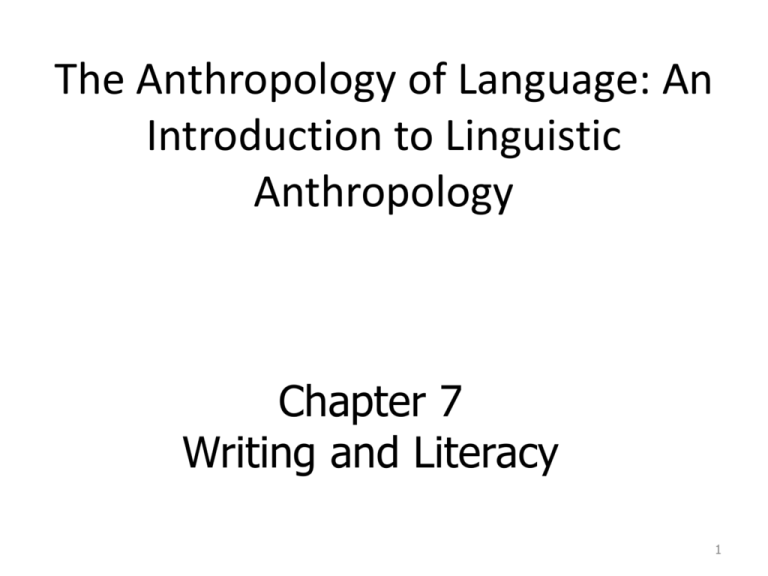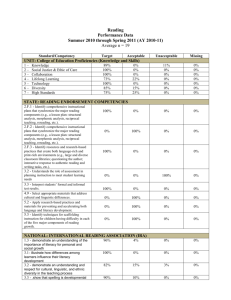ch07_Ottenheimer PPT
advertisement

The Anthropology of Language: An Introduction to Linguistic Anthropology Chapter 7 Writing and Literacy 1 Most of us are pretty good at interacting with writing, but we seldom define our terms. • Writing: – Graphic representation of language • Recording language by visible marks • Symbols that convey thought • System of storage and retrieval • Literacy – The skill of ciphering and deciphering texts 2 How Does Writing Work? • Using marks to represent sounds, ideas/meanings – Phonetic sign: mark that represents one or more sounds • English sign <s> = the sound [s] • Arabic sign < = >سthe sound [s] • But <s> can also = [z] • And <x> = [ks] – Semantic sign: mark that represents specific idea/meaning • <2> in English, French, German, Swahili, etc. – Combining phonetic and semantic signs: • <2nd> (English) • <2e > (French) 3 Classic classifications • Based on predominance of sign types – Semantic vs. phonetic signs – Ideographic/logographic vs. syllabic/alphabetic systems • Assumed progression from semantic to phonetic • This assumption does not hold up in the face of the existing data 4 Contemporary classifications • Recognize that all systems use combinations – Pictographic – Rebus – Logographic – Syllabic – Logosyllabic – Alphabetic 5 Even Pictographs must be deciphered • Pictures/images represent things – Meanings can be extended • Drawing of a sun can equal warmth • But extensions require cultural context: Is this a picture of a woman in a skirt, or a man in a kanzu, a Swahili robe? 6 Writing Systems • Writing and symbolism – Universal symbols? Arbitrary symbols? • • • • • • • What is writing? How does writing work? Kinds of systems Analyzing writing systems Developing/having writing Literacy and representation The ethnography of writing 7 What is Writing? • Graphic representation of language – Recording language by visible marks – Symbols that convey thought – System of storage and retrieval • Generally considered secondary to speech • Complete vs. partial writing systems – Complete: any and all thoughts and words – Partial: limited in what they can convey 8 How Does Writing Work? • Using marks to represent sounds, ideas/meanings – Phonetic sign: mark that represents one or more sounds – vs. phonetic symbol: linguistic transcription of a single sound • <s> vs. <ш> vs. < >שvs. < >سvs. <σ> = [s] • <ch> in English vs. French vs. German – Semantic sign: mark that represents specific idea/meaning • <2> in English, French, German, KiSwahili, etc. • <2> vs. <٢> vs. <..> – Combining phonetic and semantic signs: • <2nd> (English) • <2e > (French) 9 Kinds of Writing Systems • Old-fashioned classifications – Were based on predominance of sign types • Semantic vs. phonetic signs • Ideographic/logographic vs. syllabic/alphabetic systems – Assumed progression from semantic to phonetic – Are now understood to be ethnocentric • Contemporary classifications – Recognize that all systems use combinations • • • • • • Pictographic Rebus Logographic Syllabic Logosyllabic Alphabetic 10 Pictographic “Writing” • Pictures/images represent things – drawing of a sun = the sun • Pictographs alone are not complete writing systems – Meanings can be extended • Drawing of a sun can = warmth • Extensions require cultural context: 11 Rebus Writing • Picture represents words that sound the same: – Drawing of the sun represents (in English): • Sun and Son – Drawing of a star represents (in Sumerian): – [an] = Star, Heaven, Sky-God • A major breakthrough in writing – Allows for sentences like • Eye sea ewe, Eye c u, Got 2 go • Independently discovered in: – Sumeria 3,000 BCE – China 1,500 BCE – Mayan America 0 BCE 12 Logographic Writing • Signs stand for words (or ideas) • Also called Ideographic – One sign = one word • sign for sun = the spoken word “sun” [sən] • @ sign = “at” (in English), “herring” (in Czech) • May have evolved from pictographs – Becoming more abstract over time Chinese sign for [ma] horse; Sumerian sign for [an] star 13 Syllabic Writing • Signs stand for syllables – A sign for sun = the syllable “sun” [sən] • sunken, sunder, sundry, sunshine. Cherokee 14 Logosyllabic Writing • Signs carry both semantic and phonetic information – Useful when words are written alike – Determinatives help to clarify: • Semantic determinatives help to clarify meaning – Chinese [yang] = “sheep” & “ocean” – Semantic determinative for water produces “ocean” • Phonetic determinatives help to clarify pronunciation – English <2> = “two” “second” – Phonetic determinative <nd> produces “second” 15 Alphabetic Writing • Signs stand for individual sounds – e. g., consonants & vowels • English sign <s> = the sound [s] • Arabic sign < = >سthe sound [s] • Arabic sign < َ > = the sound [a] – Goal not always achieved: • English sign <x> = [ks] 16 Beginnings of Alphabetic Writing • 17th century BCE – Akkadians/Phoenecians adapt Sumerian system • From CVCV syllabary to tri-consonantal roots – Signs used for consonants (and vowels) » Aleph-bet / Alif-bet • 9th century BCE – Greeks adapt Phoenecian system • More vowels, fewer consonants – Reassigning some C signs to Vs » Alpha-bet 17 Khipus • A special case – Tying knots into cords • Calendrical • Economic • Historical data – May be a full-blown writing system 18 Analyzing Writing Systems • Determine the principles/strategies – Syllabic, alphabetic, etc. • Identify units – Graphemes • Smallest segment of speech represented in system – Sounds, syllables, whole words – Allographs: • predictable variants of graphemes – English print and cursive styles; initial and final shapes – Lexemes/Frames • Units of writing surrounded by white space • Look for minimal pairs, similarity of shapes – e.g., the Japanese exercise in the Workbook 19 What Does it Mean to Have Writing? • Association with “civilization” • Does an introduced writing system “count?” – The Lahu example • Developing new writing systems • How are words put together? CV, CCC, etc • Issues of identity – Spelling in the Comoros » French? Arabic? African? Phonemic? • Promoting literacy – So what is there to read? 20 Writing, Reading, Identity, Power • Learning to read and write • Defining literacy – Using what writing system? • Defining correctness – Night vs. nite • Writing and representation… 21 Writing and Representation • Entextualizing speech – Getting words onto paper • Questions of representation – Rapid speech – Dialectical speech • couahfee; warsh, crick • gonna - goin’ - gon’ - gwine – Power and politics in representation • Writing “Cousin Joe” 22 Writing and Literacy • Defining literacy • Promoting literacy – So what is there to read, and who has time to read it? • Literacy associated with particular projects • Literacy associated with particular skills or types of cognition • Understanding the impacts of literacy 23 Literacy and Literacies • What does it mean to be literate? – kinds of literacy: print, map, computer • Defining literacy – Literacy as technology • Autonomous approach – Literacy as practice • Practice approach to literacy • New Literacy Studies • Ethnographic approach – Taking context and experience into account 24 The Consequences of Literacy • Literacy and Orality – Abstract, generalizing, context-free, objective – Concrete, particularizing, situational, subjective • Bantu abstractness (ubuntu) • Vai triliteracy • Chinese and Indian literacies • Literacy and linguistic awareness – Writing “changes the way we think about language” (Coulmas) 25 Literacy and Permanence • Written records vs. oral traditions – Finding archaeological sites in the Comoros – Following clues from oral tradition 26 Literacy in Cross-Cultural Perspective • The ethnography of reading/writing – Heath’s practice approach to literacy events – How does reading/writing function in a culture? – What kinds of things are read/written? • Letters, cards, lecture notes, PowerPoint slides – Reading/writing styles (and linguistic capital) • Trackton, Roadville, Maintown – Ideas about reading/writing • When is handwriting preferred to typing? • And vice versa – Condolence letters, form letters, job applications 27 Literacy and Power • Issues of access – Who should read/write? • Issues of colonialism – Destroying Mayan writings – Introducing “book authority” in New Guinea • Issues of standardization – Dialects and politics • Issues of reform – Changing spellings • Americanizing English – Reforming scripts • Nationalism and orthography in Ukraine • Scriptal change in Turkey 28 Ways of Reading/Writing • Linear vs. multimodal reading/writing – The Machine Is Us/ing Us • Public vs. private reading/writing – Blogging • Challenges to standardization – L337 – Teh kitteh 29 Creating a Language • Optional: – Create an orthography for your language 30 Next: • How and When is Language Possible? – Read: • Textbook Chapter 8 • Workbook/Reader: – Ottenheimer & Ottenheimer (pp. 157-161) – Prepare to do: • Writing/Discussion Exercises (W/R pp. 163-166) • Language Creating (W/R p. 171) • Conversation partnering (W/R p. 172) 31






